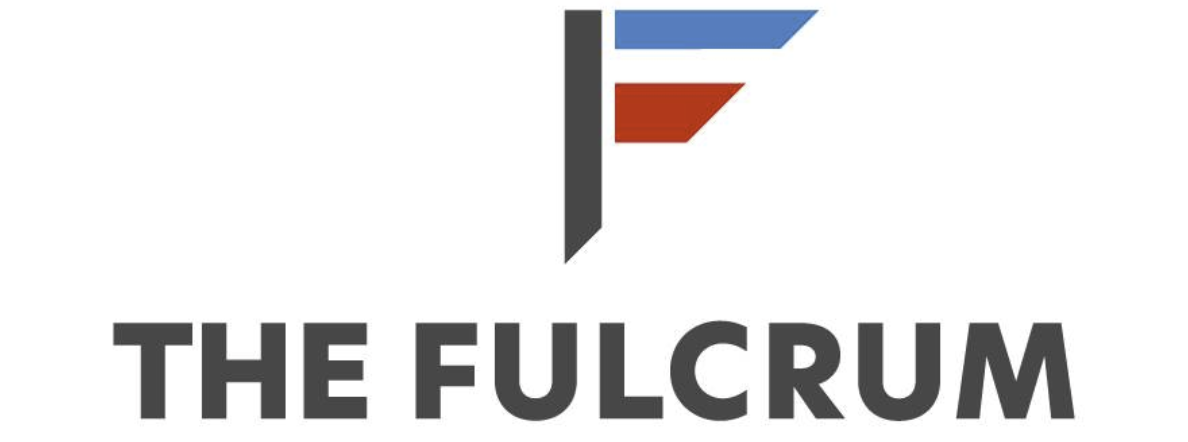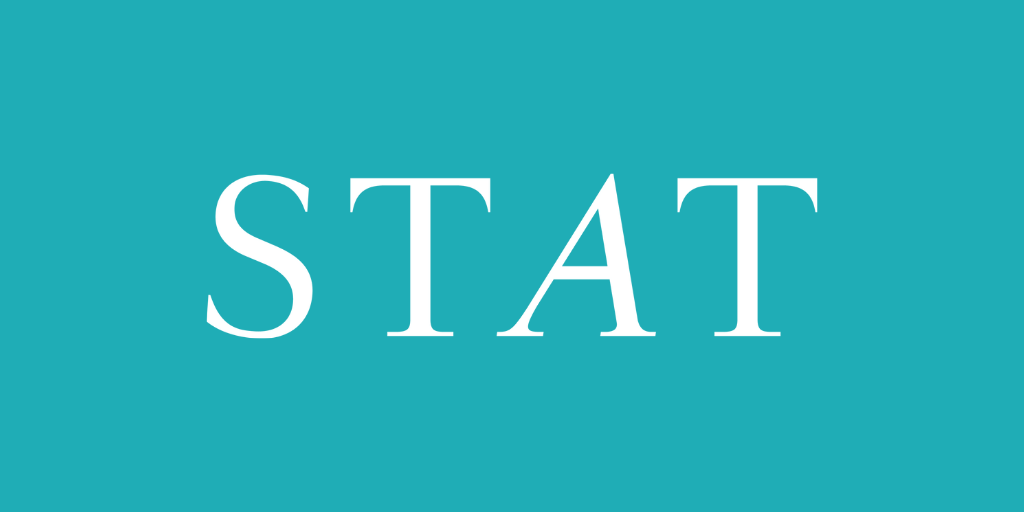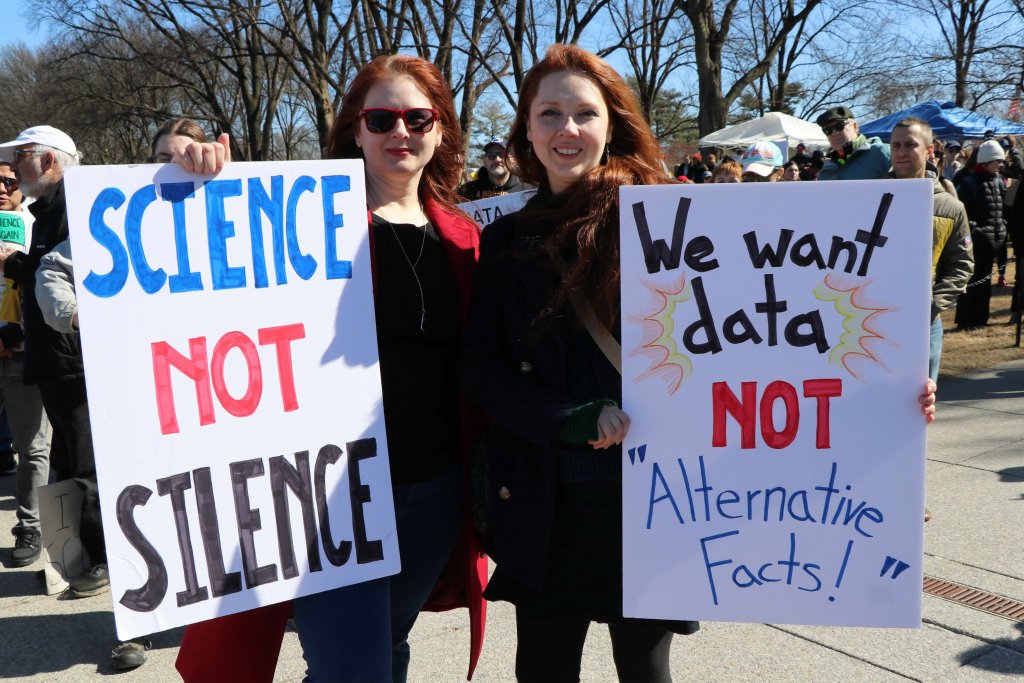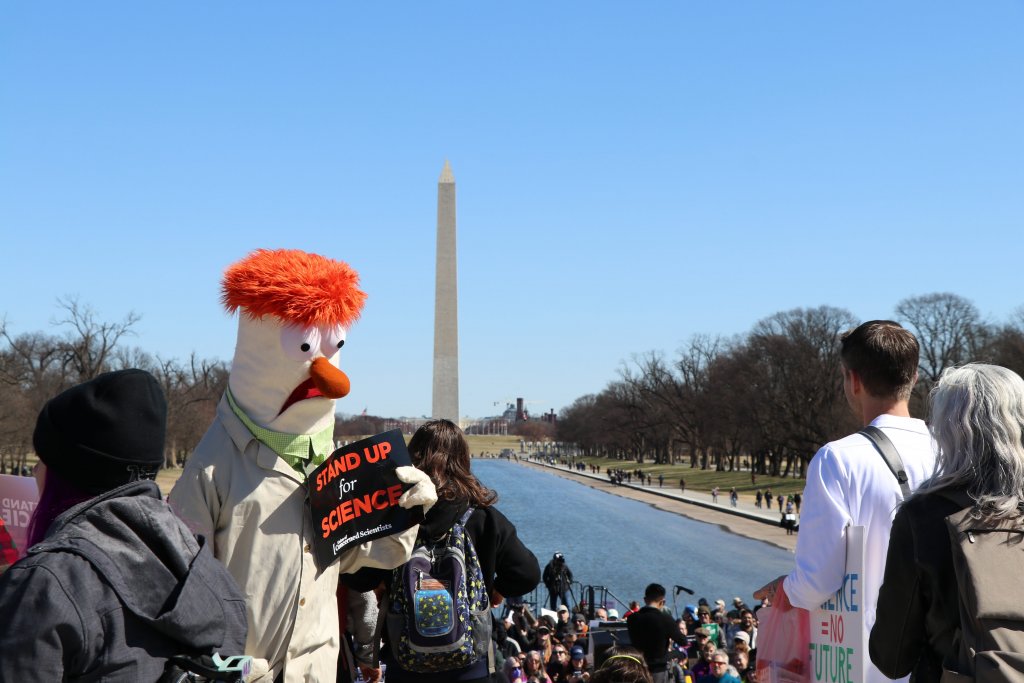Latest in Health & Science News
Get up-to-date health & science news from our reporters
WATCH: Public Health Advocates Host Historic D.C. Rally
The American Public Health Association hosted a rally to discuss public health issues and initiatives.
read more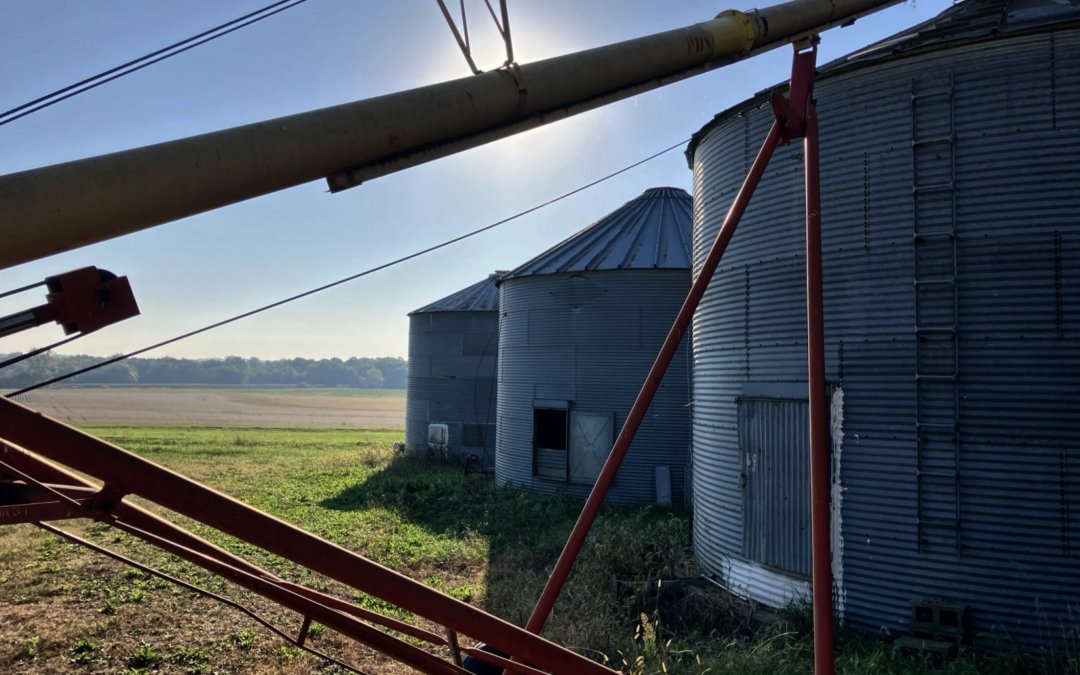
Soybean oil’s time to shine
China’s boycott of U.S. soybeans has pushed farmers to find outlets to offset the financial loss. The growing market for soybean oil may be the answer.
read more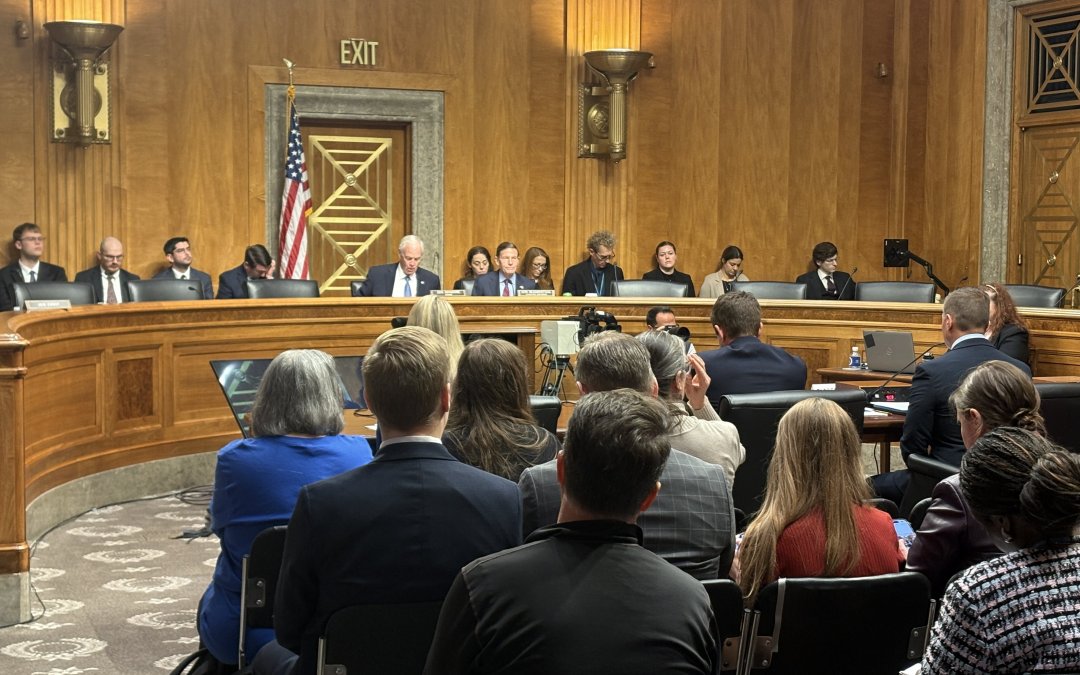
Senate Republicans, conservative think tanks criticize Affordable Care Act
Conservatives target Obamacare as premiums are set to rise.
read more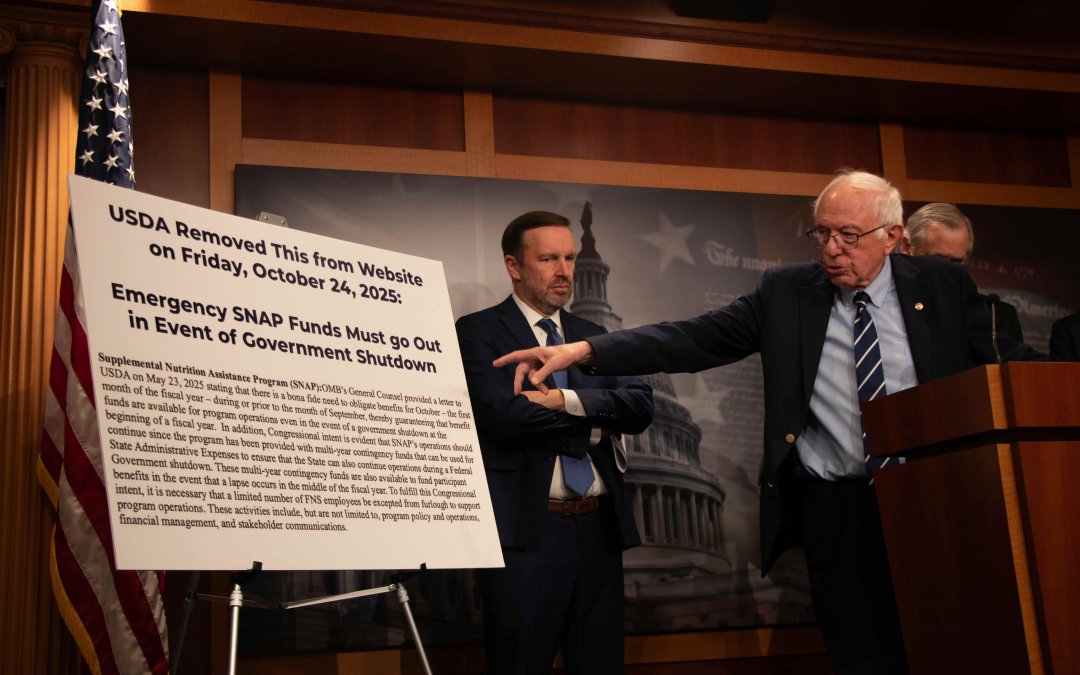
Senators raise competing legislation to continue SNAP benefits as suspension looms
Nearly one in eight Americans will lose food aid benefits on Nov. 1 due to the government shutdown, with out intervention.
read more
Lawmakers, experts warn U.S. could lose biotech edge to China
WASHINGTON — At a Senate Health, Education, Labor and Pensions committee hearing on biotechnology and U.S. competitiveness, lawmakers and witnesses warned that America risks losing its industry dominance. China now accounts for 30% of global clinical trial starts,...
read moreFinancial pressures mount for rural hospitals as Federal support programs expire
WASHINGTON — Health care administrators across rural America say financial pressures are mounting as federal support programs expire and Medicaid cuts take effect, putting many facilities at risk of closure.
In Hugo, Colorado — a town of fewer than 1,000 people — that reality is familiar. Lincoln Health, a 25-bed hospital and the only facility on the nearly 600-mile stretch of I-70 between Denver and Kansas City, Missouri, has faced financial strain for years.
“If you drive east on I-70, you care about my hospital because I’m the only thing out here if something should happen,” said Kevin Stansbury, Lincoln Health’s CEO. “We do a lot, and we do it not because any of those things are terribly lucrative. We do it because there’s no one else out here to do those things.”
Last month, Lincoln Health closed its assisted living facility due to financial constraints. Stansbury said the hospital is still evaluating how to maintain its remaining services as Medicaid cuts hit and key federal programs expire.
The federal reconciliation bill, signed into law on July 4, is projected to cut federal Medicaid spending by $911 billion over the next decade and increase the number of uninsured Americans by 10 million, according to the Congressional Budget Office. The reductions are set to take effect over the next two years.
In rural areas, federal Medicaid spending is projected to decline by $137 billion over the next decade, according to estimates from the Kaiser Family Foundation. Roughly three-quarters of Lincoln Health’s patients are covered by Medicaid or Medicare, and even before the cuts, reimbursement rates were low, Stansbury said.
Several federal programs that offered financial support to rural hospitals lapsed on September 30, including the Medicare-Dependent Hospital program, which provided enhanced payments to hospitals with a high proportion of Medicare patients, and the Low-Volume Adjustment program, which offered additional payments to hospitals with low annual discharges.
The Medicaid Disproportionate Share Hospital program, which offsets uncompensated care costs for hospitals serving a high number of Medicaid and uninsured patients, saw $8 billion in cuts on October 1.
“Not knowing whether those payment adjustments will continue is incredibly difficult for hospital administrators to be able to plan long term because they don’t know whether or not they will continue receiving those payments,” Alexa McKinley Abel, director of government affairs & policy at the National Rural Health Association, said.
Abel added that many hospitals have already been budgeting under the assumption that the cuts will remain in place.
Roughly half of the nation’s rural hospitals currently operate at a loss, according to the National Rural Health Association. Stansbury described challenges that Lincoln Health shares with many rural hospitals, including low commercial reimbursement rates and limited access to capital.
A study by the Colorado Rural Health Center found that rural eastern hospitals receive commercial payments averaging 139% of Medicare rates, compared with 240% in Denver.
“They’re just going to try to drive me as low as they possibly can,” Stansbury said. “And what it seems to be forgetting is that if I go out of business, then there’s a big area of the state that doesn’t have health care.”Moreover, built in 1959, Lincoln Health has had limited resources for major renovations. Operating on tight margins leaves little room for upgrades or construction, he said.
In some rural areas, maternity care is estimated to be the first to shut down due to its high operating costs, according to Denae Herbert of the Louisiana Rural Health Association.
“There’s not sufficient volume to really sustain a birthing center,” Herbert said. “So if there is a rural hospital still providing that service, that would certainly be at risk as well, which is very concerning, particularly because of the maternal mortality rate in Louisiana being as high as it is, we need to increase access to maternal health care, not decrease it.”
According to a 2024 report by the Center for Healthcare Quality and Payment Reform, 75% of rural hospitals in Louisiana don’t offer maternal care. The state’s maternal mortality rate stands at 37.3 deaths per 100,000 live births — among the highest in the country.
A June letter from Senate Democrats estimated that 33 rural hospitals in Louisiana are at risk of closing following the cuts.
In Virginia, that number amounts to six. But according to Sen. Mark Warner (D-Va.), these hospitals are concentrated in areas that voted overwhelmingly for President Donald Trump.
“The irony of this is that these were the communities that frankly — they voted for Trump because they wanted to lower costs,” Warner said. “Well, we’ve not seen groceries go down, we’ve not seen inflation go down, and states are seeing health care costs skyrocket.”
Lee County Community Hospital, one of the six at risk of closing under the cuts, is part of a county that voted 85.7% for Trump, according to Politico’s election map.
The situation in Oregon is similar, according to Sen. Ron Wyden (D-Ore.). He said he recently led a series of town hall meetings in rural Oregon, in communities that voted 70% for Trump. He said people are aware that a “health care wrecking ball is coming right at them.”
Wyden also echoed Herbert’s concerns about the potential increase in maternity deserts nationwide.
“You can’t have rural life without rural health care, but we are headed in that direction,” Wyden said.
While inpatient rural hospital care is facing setbacks, so is virtual care. The telehealth waiver enacted during the COVID-19 pandemic expired on Oct. 1. In most cases, providers will no longer be reimbursed for telehealth visits delivered to Medicare patients in their homes.
Abel said this is a major concern because telehealth has the potential to improve rural health care significantly. She said a longer extension of the flexibilities would have been beneficial for rural areas.
“There’s been studies showing that uptake in rural areas for telehealth has actually been less compared to in urban areas, and I think that’s because the infrastructure is not fully there yet, and without knowing that these flexibilities will be in place for the long term, it’s hard for providers to invest in it,” Abel said.
Stansbury says that while telehealth is an additional challenge, it is not a substitute for in-person care.
“If somebody gets in an automobile accident on I-70, telemedicine does nothing for that,” he said. “I need people on the ground who are able to receive those patients and take care of them effectively.”
For patients who rely on these hospitals daily, the combination of aging facilities and policy changes is tangible. Limon, Colorado resident Lorie Coonts has been using Lincoln Health’s services for four decades. Despite the hospital’s deteriorating condition, including shared bathrooms and the absence of OB-GYN services, Coonts said the hospital is like “family taking care of family.”
She said she worries about the hospital’s financial instability and risk of closure, noting that if Lincoln Health were to close, the small community would dwindle further.
“It just feels like the hospitals are faced with one thing and one after the other,” Coonts said. “It just feels like it’s more and more mandates and rules … that just keep things from being easy and being able to afford it. Every time we turn around we get slapped in the face with something else.”
Senate weighs AI’s role in health care amid safety, regulation concerns
WASHINGTON – At an Oct. 8 Senate Health, Education, Labor and Pensions Committee (HELP) hearing, lawmakers examined how artificial intelligence is reshaping health care — from easing paperwork to raising new safety concerns, including reports of chatbot-linked teen suicides.
Sen. Bill Cassidy (R-La.), chairman of the committee, set the tone of the hearing during his opening statement, highlighting AI’s potential to accelerate drug discovery and lower health care costs while warning of its darker consequences, including recent parent allegations that chatbots induced teen suicides.
“There is enormous potential to improve people’s lives; there is enormous risk,” Cassidy said.
Stanford bioengineering professor Dr. Russ B. Altman, a witness at the hearing, said AI can change health care in three main ways: augmenting clinical diagnoses, giving providers more time with patients and giving patients more control over their care.
In response to Altman’s testimony, Sen. Susan Collins (R-Maine) broached the subject of whether AI can help struggling rural hospitals, which she said are “teetering on the brink of closure.”
Altman said AI is both an opportunity and a challenge for rural hospitals. He says it could potentially help hospitals provide more specialized care closer to home.
“I think that this is a great opportunity to extend the capabilities of rural hospitals but I think they would tell you right now that they need help in vetting these tools and right now it’s a tsunami that they can’t manage,” Altman said.
He proposed creating an oversight body that lays out best practices, vets tools and formulates guidelines for hospitals, as a solution.
A recurring topic at the hearing was the recent examples of chatbot-associated teen suicides — most notably, at a judiciary hearing last month, Florida mother Megan Garcia alleged that prolonged abuse by AI chatbots on a platform called Character.AI led to her 14-year-old son’s suicide.
Sen. Josh Hawley (R-Mo.) posed the question of how AI can be regulated to prevent the “killing of kids” to witness John Bailey, a senior fellow at the American Enterprise Institute.
“Aren’t we beyond there being a potential problem that maybe we need to have a little further development before they release the models?” Hawley asked. “Doesn’t Congress need to do something now in order to protect kids from being killed by AI systems?”
Bailey said researchers don’t fully understand why chatbots behave in harmful ways and called for human intervention when conversations become dangerous, as well as greater transparency from companies.
Hawley pushed back, stating that he’s beyond the point of transparency and wants companies to “stop killing kids.”
Several lawmakers returned to the issue throughout the hearing, including Sen. Jon Husted (R-Ohio) who directed the committee to a bill he recently introduced: Children Harmed by AI Technology Act of 2025 (CHAT).
The bill requires owners and operators of AI companion chatbots to bar minors from accessing adult content and parental consent for minors to use chatbots. It would also mandate the chatbot immediately inform consenting parents if the conversation with a child includes self-harm or suicidal ideation.
Sen. Ashley Moody (R-Fla.) said that companies should be held liable for their chatbots causing harm or death to users. She also posed the question of how lawmakers can regulate AI.
Both Altman and Bailey said any regulation should begin with clearly defining who is responsible when AI systems cause harm.
“I think we need principles of where does liability fall there as it relates to the developers of AI, the deployers of AI and then how does that relate to both users and then also AI agents,” Bailey said.
Lawmakers, experts propose solutions to health, security risks of foreign-manufactured drugs
WASHINGTON – Lawmakers and experts argued that the U.S. supply chain’s overreliance on foreign-manufactured medicines, particularly from China and India, poses both health and national security risks during a Senate hearing on Wednesday.
The Senate Special Committee on Aging held the hearing after a recent ProPublica investigation uncovered that the FDA silently allowed over 20 overseas factories to continue sending medicines to the U.S., even though they were manufactured at plants the agency had banned because of contamination and other violations.
“The federal government needs to ensure access to safe and high-quality drugs now,” said Committee Chairman Sen. Rick Scott (R-Fla).
On Tuesday, Sen. Scott urged Department of Commerce Secretary Howard Lutnick and U.S. Trade Representative Ambassador Jamieson Greer to place tariffs on foreign-made generic drugs. He also announced legislation on country of origin labeling for prescription drugs.
Other solutions proposed during the hearing included establishing a federal buyer’s market, strengthening the oversight of foreign manufacturing facilities, and increasing domestic government contracts.
“Americans shouldn’t have to worry about the quality of their prescriptions, whether they’re safe to be able to take, whether they’re effective, what will happen if the supply chain breaks,” said Sen. Elizabeth Warren (D-Mass.). “And for me, that’s reason enough to manufacture right here in the United States, and using federal contracts to lower those production costs.”
Tony Sardella, founder of the API Innovation Center, said that 83 of the top 100 generic drugs consumed by U.S. citizens lack a U.S.-based source for their active pharmaceutical ingredients (APIs). As of 2022, 91% of all prescriptions in the U.S. are for generic medicines, according to the FDA Office of Generic Drugs.
A study of FDA warning letters headed by Sardella found that one in every four prescriptions in the U.S. is supplied by a facility that has received an FDA violation since 2020.
“We don’t want to be alarmist,” said Sardella. “Some of these are very simple paper and procedural warning letters, but it does include others where there’s more severe issues, quality issues, safety issues, manufacturing issues, impurity issues.”
Lawmakers also discussed the danger of relying on drugs manufactured overseas and the national security risks.
Ranking Member Sen. Kirsten Gillibrand (D-N.Y.) said the long-term cost of poorly-manufactured medicines and risks to national security is likely much higher than the cost of compounding and manufacturing these drugs in the U.S..
“If we’re at war with China, and you can’t get antibiotics into this country, and how many millions of people die, the cost of that is trillions of dollars. It’s incomprehensible,” she said.
Dr. Marta E. Wosińska, Senior Fellow at the Center on Health Policy at The Brookings Institution, said the level of engagement and bipartisan cooperation by legislators was “striking.”
“I was really, really glad to see this hearing being put on by Senate Aging,” she said, “because the members of this committee sit on a lot of really other critical committees of jurisdiction where they can actually put a lot of these policies in place.”
Despite all of the concerns about where the drugs originate, Dr. Wosińska stresses the importance of continuing to take prescribed medicine.
“It’s still much better to take a Chinese drug than not to take one,” she said.
Bill Nye, Rep. Ivey fight proposed NASA cuts
WASHINGTON – Bill Nye, the “Science Guy,” called for Congress to reject the White House’s proposed cuts to NASA’s funding.
Nye is a long-time television personality and CEO of the Planetary Society, a nonprofit organization that promotes space exploration. He gathered with around 300 advocates at the U.S. Capitol on Monday as part of the society’s annual Day of Action to maintain NASA’s budget.
The proposed White House budget for the 2025-2026 fiscal year, which began Oct. 1, slashes NASA’s funding by 24%, from around $24.8 billion to $18.8 billion.
Science research funding, which includes Earth science, planetary science and astrophysics, would be hardest hit by an unprecedented 47% cut.
In a bipartisan rejection of these proposals, both the House and Senate budget drafts leave NASA’s overall funding untouched at the current $24.8 billion.
Eight representatives also signed a letter to the House Committee on Appropriations in September. Signees represented both parties, including Rep. Don Bacon (R-Neb.) and Rep. Judy Chu (D-Calif.).
But Congress is far from finalizing a budget. And amid a government shutdown that has furloughed more than 15,000 of NASA’s 18,000 workers, the Trump administration’s budget recommendation could put agency funding on the chopping block.
Nye said most people do not consider the economic benefits of NASA’s research. Every dollar spent, he said, returns $3 to the U.S. economy.
NASA’s projects generated more than $75.6 billion and 300,000 jobs nationwide in the 2023-2024 fiscal year, according to its most recent report.
Indeed, Nye said most modern technology would not exist without research in space and science.
“The reason we’re able to have this recording on your phone is because of investments in space,” Nye told Medill News Service.
These innovations, along with numerous space missions, have helped develop NASA into a global brand, he said.
But the Trump administration’s proposed budget terminates what it calls “unaffordable” projects like Mars Sample Return, a mission that aims to bring samples from Mars back to Earth.
This would cause the U.S. to fall behind China in space exploration, Rep. Glenn Ivey (D-Md.) said.
“China is doing the exact opposite,” Ivey told Medill News Service. “They’re pushing money and engineers and talent towards these sorts of research fields and giving them every opportunity to thrive. We should be doing the same thing.”
Ivey said the cuts would also risk NASA’s early career resources. These include fellowships that fund graduate students like Columbia University Ph.D. student Kalima Bukenya.
Bukenya, a former NASA intern, told Medill News Service she visited Washington, D.C. for the first time to attend the Day of Action.
“My future is invested in just being able to work for NASA,” Bukenya said. “To have these cuts, I don’t know what I’m going to do next.”
Pfizer strikes drug pricing deal as Trump announces TrumpRx
WASHINGTON — President Donald Trump just announced a plan for TrumpRx, a new, government-run, direct-to-consumer online pharmacy.
It comes a day after Trump’s deadline for pharmaceutical companies to lower costs on prescription drugs. On July 31, Trump wrote a letter to the 17 largest pharmaceutical companies demanding that they align their drug prices to those of other high-income countries, a policy known as most-favored-nation pricing, by Sept. 29.
Pfizer is the first to announce a deal with the Trump administration, agreeing to voluntarily sell its medications to Medicaid at discounted prices in line with other developed nations as well as sell their drugs at a discount direct to consumers on the new TrumpRX site.
“I think today we’re turning the tide, and we are reversing an unfair situation,” said Pfizer CEO Albert Bourla in a press conference with Trump on Tuesday.
Other pharmaceutical companies have taken initial steps to close the pricing gap between U.S. and foreign markets, with AbbVie and Bristol Myers Squibb recently pledging to launch their respective drugs in the U.K. to match the higher list price in the U.S.
The Pfizer deal is unlikely to have a large impact on reducing drug costs for the vast majority of Americans who have private health insurance, said Vincent Andolina, a retired pharmaceuticals regulatory expert. That’s because the cost reductions offered on TrumpRx are only accessible to patients who forgo using insurance, and consumers would likely pay less through insurance, despite how large TrumpRx discounts are.
For the more than 70 million people on Medicaid, they already receive the lowest price offered in the drug marketplace by law, so patients often pay minimal amounts out-of-pocket to start.
Americans pay nearly three times more for brand-name drugs than other developed countries, according to a 2024 report from the RAND Corporation, a nonpartisan research organization.
Pharma companies have argued that lowering prices would mean less money for research and new drug discoveries, but Lindsay Allen, a health economist at Northwestern’s Institute for Public Health and Medicine, disagrees.
“We know that drugs can be priced at what they are priced in other countries, and it will not harm the type of innovation that we’d like to see,” Allen said.
The discrepancy between prices in the U.S. and other developed countries is due to a number of factors, including the lack of pricing transparency and differences in health systems.
Most European countries use single-payer health care, meaning the government negotiates with manufacturers to determine drug prices. This gives the government leverage to determine the maximum price of a drug or even prevent a drug from getting to market if the pharmaceutical company doesn’t agree to a certain price.
In the U.S., most drug prices are negotiated by pharmacy benefit managers (PBMs) who serve as middlemen between pharmacies, insurers, and drug manufacturers. These PBMs don’t have to disclose certain costs, such as how much a drug costs a manufacturer to make and how much it gets sold to the pharmacy for.
PBMs also have an incentive for promoting certain branded drugs: rebates. Drug companies offer rebates to PBMs to get their drug a preferred status on the formulary, or the list of medications that can be prescribed. This favored status allows manufacturers to sell more of their drug, but the rebates do not lower the out-of-pocket costs that the customer pays. The PBM can retain the savings from those rebates.
Pharmaceutical companies, including Eli Lilly, Pfizer and AstraZeneca, have recently launched their own direct-to-consumer platforms, but Andolina said he’s skeptical of their efficiency.
“Direct-to-consumer, to me, doesn’t make sense, and regulation of pharmacy benefit managers makes more sense,” Andolina said.
Timothy McBride, a professor at Washington University in St. Louis’s School of Public Health, argues that a better approach to saving all consumers money on drug costs is for the government to focus more on using Medicare to negotiate prices. Which in turn can cut costs for everyone.
“The government is one of the biggest purchasers of drugs in the country,” McBride said. “We just haven’t used that power, basically, to go in and say, ‘Look, we’re buying millions of dollars of drugs, and we think the price is too high.’”
Michigan Democrat to introduce articles of impeachment against RFK Jr
WASHINGTON – Representative Haley Stevens (D–Mich.) announced Thursday that she will introduce articles of impeachment against Health and Human Services (HHS) Secretary Robert F. Kennedy, Jr.
“Enough is enough,” Stevens said in a statement. “We need leaders who put science over chaos, facts over lies, and people over politics.”
Stevens’ announcement comes after Kennedy’s contentious congressional testimony over vaccine policy, and his linking of Tylenol use and autism without evidence.
In response to Stevens’ plan to file articles of impeachment against Kennedy, HHS Director of Communications Andrew Nixon told the Medill News Service, “Secretary Kennedy remains focused on the work of improving Americans’ health and lowering costs, not on partisan political stunts.”
In a press release, Stevens refers to Kennedy’s “ongoing efforts to jeopardize public health, increase the cost of healthcare, and cut critical medical research” as key motives behind her push to remove him from office.
“RFK Jr. is making our country less safe and making healthcare less affordable and accessible for Michiganders,” Stevens said in a statement.
According to the press release, Stevens’ articles of impeachment against Kennedy will primarily center on his lying in his confirmation hearing and failing to carry out statutory duties of HHS, as well as his cutting of funds for lifesaving research, restricting access to vaccines and raising healthcare costs.
Some of the points brought up in Stevens’ call to impeach Kennedy also mirror concerns of other members of Congress.
Representative Laura Gillen (D–N.Y.) has spoken out against what she referred to as the “deeply disturbing” federal budget cuts to childhood cancer research – one of the specific actions listed by Stevens for impeachment.
At a press conference on pediatric cancer research cuts last week, Gillen said the cuts were detrimental to America’s image as a leader in healthcare research and innovation and that the only way for the nation to continue to be a “beacon of hope” for medical research is “not by cutting funds to research, but by continuing it.”
Stevens says not only is it bad for America’s image but Kennedy’s actions are “unprecedented, reckless, and dangerous.”
“Secretary Kennedy has violated his oath of office and proven himself unfit to serve the American people,” Stevens said. “Congress must act to hold him accountable, and I intend to lead the charge to remove him from office.”
Stevens has not said when she plans to file the articles against Kennedy. Historically, only two cabinet members have ever been impeached by the House, though neither were convicted by the Senate.
Experts Warn Current Fentanyl Legislation Fails to Address Root Problem: Fentanyl
WASHINGTON — Five days after discovering their 16-year-old son Daniel Puerta unresponsive in bed, Jaime Puerta and his wife decided to discontinue life support as they stood beside him in the Los Angeles Children’s Hospital. Puerta kissed his son’s nose one last time.
Daniel, who had no history of substance abuse, is one of countless stories tragically connected to the nation’s opioid crisis. Over the past decade, synthetic opioids have claimed over 450,000 American lives, and left millions more struggling with addiction.
Five years after his son’s death, Puerta recounted the tragedy before the Senate Judiciary Committee in February, explaining that his son took half a counterfeit pill that was, unbeknownst to him, laced with illegally manufactured fentanyl.
“My son had consumed what he thought was a blue M30 Oxycodone pill, but in fact, had unknowingly, I repeat, unknowingly, ingested an illicitly manufactured counterfeit opioid,” said Puerta, co-founder of the nonprofit VOID, which educates students nationwide on the dangers of drugs, at the hearing.
Now, in an effort to address the public health crisis, the Senate recently passed the HALT Fentanyl Act in an 84-16 vote. A similar version previously passed in the House of Representatives, and the White House has expressed support as well.
However, experts question whether the bill truly addresses the roots of the epidemic, for two main reasons. For one, the bill focuses on increasing penalties for fentanyl-related substances, a version of the drug that’s far less prevalent than fentanyl itself. Plus, the critics say the bill extends the punitive approach of the War on Drugs without addressing systemic factors driving the crisis.
Fentanyl-related substances (FRS) are drugs with a slightly different chemical structure but comparable effects to fentanyl. The bill permanently classifies all of them as Schedule I substances and imposes a 10-year mandatory minimum sentence for anyone in possession of 100 or more grams of FRS. According to the Drug Enforcement Administration (DEA), drugs in that category, like heroin and marijuana, have “a high potential for abuse and no currently accepted medical use.”
FRS have been classified as Schedule I since 2018, with Congress continually extending the designation through 2025. The proposed legislation makes it a permanent status.
Puerta said that the HALT Fentanyl Act is long overdue. He supports the bill because he believes it will prevent illegal manufacturers from exploiting loopholes and evading prosecution.
“We don’t want any other parents to have to be in our same shoes. And what we’re trying to do is provide law enforcement with the necessary tools that they need so that they can go after these large drug trafficking organizations,” he said in a recent interview with STAT.
Supporters say that the bill’s approach to combating fentanyl-related substances is necessary to tackle the crisis.
“We are losing thousands of lives every single year across our country to fentanyl overdoses. This is one more tool to be able to combat that,” said Sen. Martin Heinrich (D-N.M.), a key sponsor of the bill.
Sen. Chuck Grassley (R-Iowa), the chairman of the Senate Judiciary Committee, where the bill was introduced, called it a “critical step towards ending the crisis that’s killing hundreds of thousands of precious American lives.”
The opioid crisis has evolved from the widespread misuse of prescription painkillers to heroin, and as law enforcement cracked down on heroin, illicit markets shifted toward fentanyl, which is cheaper and far more potent.
However, the difference between fentanyl-related substances and illegally manufactured fentanyl, or IMF, raises doubts among experts about the bill’s effectiveness. IMF is fentanyl itself – produced in unregulated, illegal labs and often mixed into street drugs. The Centers for Disease Control and Prevention reported approximately 72,000 deaths involving IMF in 2023, accounting for roughly 70% of all U.S. overdose deaths. IMF is not considered a fentanyl-related substance (FRS) and is already outlawed under the Controlled Substances Act.
The HALT Fentanyl Act is “not a helpful response because it’s not talking about the primary driver of the crisis,” said Travis Rieder, director of the Master of Bioethics program at the Johns Hopkins Berman Institute of Bioethics.
“The thing that is killing people right now when it comes to drug overdose is that there is fentanyl – not fentanyl analogs – illegally manufactured, unregulated fentanyl in the streets,” he said.
Rieder said that this bill goes after drugs like carfentanil, a highly potent analog used to care for large animals, “which is not a big problem on the street.” The CDC reported 210 carfentanil-related deaths, accounting for approximately 0.2% of total overdose deaths in 2023.
At February’s committee hearing on the bill, Sen. John Cornyn (R-Texas) said that the bill would help curb a sharp rise in deaths tied to carfentanil.
Additionally, Rieder said the HALT Fentanyl Act’s 10-year mandatory minimum sentencing could hurt individuals struggling with addiction.
“Doubling down on criminalization and law enforcement penalties isn’t the solution to the drug crisis,” Rieder said. “Addiction is defined as continuing to use substances despite negative consequences. Threatening jail time won’t stop people from using drugs – it will just put them in jail after they continue using. This is a harm-expanding philosophy, not a harm-reducing one.”
Susan Thau, a public policy consultant for the Community Anti-Drug Coalitions of America, said the legislation is “one piece of the puzzle” intended to target high-level traffickers who manufacture and sell fentanyl-related substances, not individuals struggling with addiction.
Patrick Royal, spokesperson for the National Sheriffs’ Association, which strongly backed the measure, said it provides law enforcement with the tools to target major traffickers.
He conceded that the War on Drugs has not always been effective but said that classifying fentanyl-related substances as Schedule I would better align criminal penalties with the dangers.
Sen. Cory Booker (D-N.J.) was one of the few lawmakers to vote against the bill in the Senate. He said he opposed it because it is overly focused on using law enforcement to combat the opioid crisis.
“Criminalization alone cannot stem the crisis of overdose deaths. We need to prevent overdoses before they happen, but this bill does nothing to curb demand, stem the flow or emergence of new drugs, or help people free themselves from the darkness of addiction,” he said in a statement.
Daniel Landsman, vice president of policy for Families Against Mandatory Minimums, criticized the legislation’s “familiar sledgehammer approach to a problem that needs a holistic and informed solution.”
He’s concerned about mandatory minimums, which link sentencing solely to drug quantity while ignoring context and individual circumstances. He warned that applying these penalties to all fentanyl-related substances is risky, as many remain untested, making a one-size-fits-all approach unjust.
Maritza Perez Medina, director of federal affairs at the Drug Policy Alliance, has tracked this bill since 2018.
She said the legislation is concerning because “it’s never how we’ve done drug policy in this country.”
She said that typically, analogs undergo scientific and medical evaluations, but this process is being bypassed, treating them all as equally harmful, even though a small molecular change could make some “therapeutic.”
Rieder said he believes the proper way to address the fentanyl crisis is investing time and money into addiction treatment services.
“We have several million people addicted to various drugs, so we need addiction medicine and treatment infrastructure many times larger than our current one, requiring immense training we haven’t invested in,” he said.
Daniel’s father, Jamie Puerta said he thinks that comprehensive action like reducing drug demand, expanding addiction treatment, and launching national awareness campaigns, as well as holding countries accountable are all important to combatting the crisis.
“Anytime I hear of a new death, it’s a gut punch. It’s like, ‘Okay, I’m not doing enough,’” he said. “There’s a lot more that needs to be done.”
Photo Gallery: ‘Stand Up for Science’ rally draws lawmakers, Bill Nye and thousands more to National Mall
WASHINGTON – White lab coats dotted the crowd gathered in the shadow of the Lincoln Memorial on Friday afternoon. Some attendees accessorized with oversized cardboard syringes, while others wore safety goggles pushed up onto their foreheads; this was – you guessed it – a march for science.
The Stand Up for Science protest drew several thousand people to the National Mall, and thousands more across the country and the world. In response to the Trump administration’s drastic cuts to government-funded research, they demanded funding be restored, protested political interference in science, and supported diversity, equity and inclusion initiatives in STEM.
Many waved whimsical signs sporting science-themed critiques of the Trump administration. “Trump’s experiments with our democracy won’t pass peer review,” one read. Another sported the slogan “Making a statistically significant difference.”
To attendees’ delight, Dr. Francis Collins, who headed the National Institutes of Health until 2021, led the crowd in a sing-along, and award-winning science communicator Bill Nye (the Science Guy) gave an impassioned speech in defense of science later in the afternoon.
The diverse speaker lineup also included Sen. Chris Van Hollen (D-Md.), Rep. Jamie Raskin (D-Md.) and Illinois Rep. Bill Foster (D-Ill.), who is the only Ph.D. physicist in Congress.
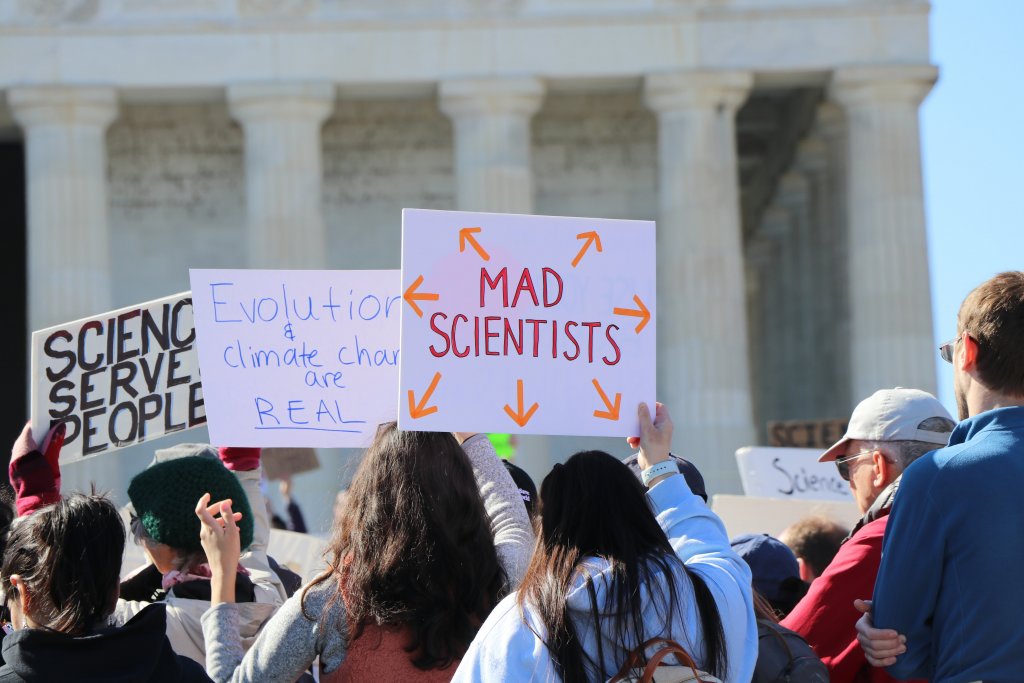
In the shadow of the Lincoln Memorial, thousands gathered to express their frustration with the Trump administration’s attitude towards science. (Sasha Draeger-Mazer/MNS)
Eight years ago, the first March for Science, held just a few months after President Donald Trump’s 2017 inauguration, drew tens of thousands of people to the National Mall. The global attendance was estimated at upwards of one million.
Friday’s gathering on the Mall was smaller, with just a few thousand in attendance, but again driven by a sense of urgency and fears about the administration’s new policies might mean for the future of science.
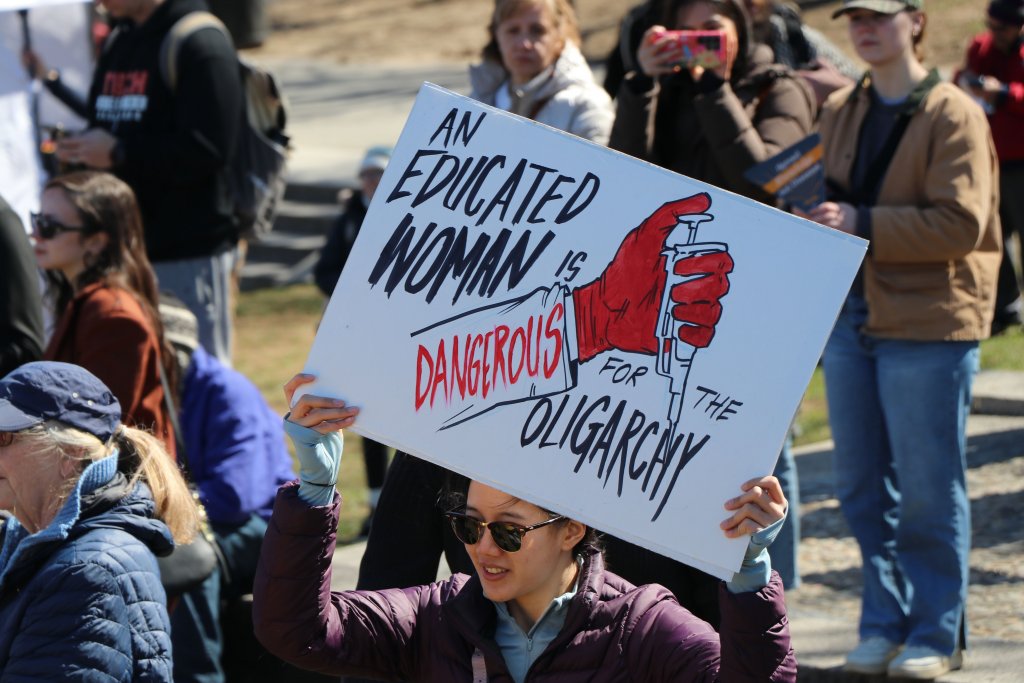
Many signs expressed anger at the Trump administration, Republican lawmakers and, frequently, DOGE head Elon Musk. (Sasha Draeger-Mazer/MNS)
Since Trump retook office in January, his administration has dealt severe blows to government-funded science and research. Proposed changes to the grant allocation policy of the National Institutes of Health may threaten life-saving research, and several Trump cabinet nominees have openly contradicted proven scientific findings.
At the rally, many signs denounced Robert F. Kennedy Jr., Trump’s newly confirmed health and human services secretary, whose nomination cleared the Senate despite his history of promoting vaccine-related conspiracy theories.
Also a frequent target: Elon Musk, the billionaire-turned-presidential-advisor. Many signs called for the defunding of the Musk-led Department of Government Efficiency, or DOGE.

Lucas Dillard and Riley Auer posed with their signs on the steps of the Lincoln Memorial. (Sasha Draeger-Mazer/MNS)
Lucas Dillard, a biophysicist, and Riley Auer, a behavioral scientist, made the trip up from Baltimore to, as Auer put it, “defend everyone’s right to a liveable future.”
“Science is a boon to our economy,” Dillard said. “If the defunding of science continues, the economic prosperity that America has seen will decline and we will become a faded superpower.”
China, he added, is doing the exact opposite for its science community: stepping up support and promoting research.
“They have increased funding to all of their universities in the past few years, and they will kind of eat our lunch,” he said.
Auer is a behavioral scientist; she once worked for the U.S. Agency for International Development and expressed concerns over the damage she said the administration has done to the agency.
“We’re relying on surveys that are sometimes five, ten years old already, and now we’re looking at a data crisis,” she said.
Rebecca and Jessica Blair drove almost six hours from Charlotte, N.C. to attend the rally. Neither are scientists, but came to show their support for the science community.
“My brother, he has a brand new baby, a newborn,” Rebecca Blair said, “and I’m worried that that baby’s going to grow up and not have access to the vaccines that she needs to grow up healthy, the way that we did.”
Her sister, Jessica, pointed to the increasing frequency of natural disasters in their home state.
“Climate change is a big issue for us, watching everybody being either on fire or flooded,” she said.

Someone in the crowd flew an upside-down American flag, a symbol historically used to signal distress. (Sasha Draeger-Mazer/MNS)
“A little fun fact: our estimates several years ago suggested every dollar the government invested in the human genome project led to $141 in economic returns,” said Dr. Collins, the former NIH director. “Science is responsible for more than 50% of the economic growth of the United States since World War II.”
Also present to recount their stories were several speakers who owed their lives to scientific innovations.
“Without funding research that went into developing the treatment that saved my life, I wouldn’t be here today,” said Emily Whitehead, who was diagnosed with a form of leukemia when she was five. After chemotherapy failed, she became the first pediatric patient treated with a novel experimental immunotherapy; now a sophomore in college, she has been cancer-free for nearly 13 years.
“I stand up for science because science saved my life,” she said, “and that is a fact.”

“Bill, Bill, Bill, Bill!” The crowd chanted along to Nye’s eponymous theme song. (Sasha Draeger-Mazer/MNS)
Bill Nye, perhaps the event’s most anticipated speaker, jogged onto the stage to the theme music from his signature show “Bill Nye the Science Guy.”
“The process of science, along with our hard-won scientific body of knowledge, has enabled us to feed and care for the world’s billions, build great cities, cure diseases, create global transportation and communications systems, and even know our place among the stars,” Nye told those gathered.
Gesturing towards the dome of the Capitol in the distance, he implored lawmakers to stand up to the Trump administration.
“Science is part of the American story,” Nye said. “If the United States is to lead the world, science cannot be suppressed.”
SCOTUS debates a death-row inmate’s request for DNA testing
DNA evidence — including scrapings underneath Harrison’s fingernails and a loose hair wrapped around one of her fingers — was recovered but has never been tested.
A Texas statute permits DNA testing only where favorable results would prove innocence, not ineligibility for a death sentence. On Monday, justices heard arguments over whether Gutierrez has the legal right, or standing, to request the post-conviction DNA testing.
The focus of the question was not whether Gutierrez was innocent, but whether he should face the death penalty. His execution was put on hold in 2024 — the second time the Supreme Court halted his execution — after the Court ruled in the similar case Reed v. Goertz that Rodney Reed had the legal right to sue Texas over its refusal to grant him access to post-conviction DNA testing.
For the last 14 years, Texas courts have denied Gutierrez’s requests to seek postconviction DNA testing of the crime scene and autopsy evidence to prove that his limited culpability in the murder would render him ineligible for the death penalty. They did so on the basis that Gutierrez did not have the legal right, or standing, to challenge the constitutionality of a provision of Texas’s postconviction DNA testing statute, which permits testing affecting an inmate’s conviction but not his punishment.
Anne E. Fisher, representing the petitioner, argued that certain procedures in the Texas post-conviction statute known as Chapter 64 that blocked post-conviction DNA testing were unconstitutional and that Gutierrez should not have been denied DNA testing.
“It’s not Mr. Gutierrez who keeps switching his position,” Fisher said. “We are simply reacting to the brand new arguments that respondents have come up with late in the process as to why we don’t have standing.”
To show that Gutierrez is ineligible for the death penalty, Fisher said she would need to show that he was not in the house and that he was not a “major participant” in the death of Harrison. Obtaining DNA testing would be one component of doing so.
Chief Justice of the United States John Roberts questioned whether a “tiny thimbleful of additional evidence” would help Gutierrez and Justice Samuel Alito pointed out that “at most, it could show that other people were there.” But Justice Brett Kavanaugh seemed among several justices sympathetic to Gutierrez. He observed that even if the district attorney refused to grant Gutierrez access to post-conviction DNA testing, he would still have the legal right to sue.
“I don’t see how we can say something’s not redressable just because the prosecutor is going to say, ‘I’m not going to comply with a court order,’” Kavanaugh said. “You know, if President Nixon said, ‘I’m not going to come turn over the tapes no matter what,’ you wouldn’t say, ‘Oh, I guess we don’t have standing to hear the executive privilege case.’”
However, William F. Cole, representing the respondents, argued that Reed v. Goertz was applied correctly and Gutierrez did not have standing to challenge the constitutionality of the DNA testing statute that permits testing affecting an inmate’s conviction but not his punishment. He also argued that Gutierrez had not challenged all the procedures needed to get the remedy for his injury — the denial of access to DNA testing evidence.
“That’s binary,” Cole said about Gutierrez’s assertion of his injury. “Either you get it or you don’t.”
Justice Ketanji Brown Jackson seemed particularly interested in clarifying the theory of redressability in the case, while Justice Sonia Sotomayor seemed to lean in favor of Gutierrez, pushing back on Cole’s argument.
“Don’t you want to know you’re convicting the right person for the right thing? I mean, he’s going to spend time in jail no matter what because he admits to being at least an accessory to the robbery or a part of the robbery,” Sotomayor asked. “But at what point does this legal maneuvering become counterproductive to the state? If you are sure of your conviction and your theory, why not do the testing?”
Cole responded that Gutierrez previously made a “strategic choice” not to undergo DNA testing when it was available to him and that even if the evidence were exculpatory, it would not change Gutierrez’s sentence because he is still eligible for the death penalty.
The justices appeared to be divided. The Supreme Court challenged both lawyers by posing hypothetical situations and clarifying questions over issues of redressability and standing.
But to Miriam Becker-Cohen, the case appeared straightforward. Becker-Cohen is the lead author of an amicus brief in Gutierrez v. Saenz from the Constitutional Accountability Center, an organization focused on examining the whole Constitution’s history to uphold progressive values at its core.
Becker-Cohen emphasized that the case boils down to the simple question of whether a death-row inmate has the right to go to court and say that the DNA testing statute violates their right to a fundamentally fair process under the Constitution under the due process clause.
“This case isn’t going to decide whether or not he gets the death penalty. It’s not going to decide whether or not he’s exonerated or something,” Becker-Cohen said. “It’s really just a narrow issue: it’s whether he gets into court in the first place, which seems like such a fundamental thing that he should be entitled to under our concept of federal standing law and jurisdiction.”
Parents, lawmakers and experts debate the fentanyl crisis and Trump’s tariffs
WASHINGTON – The Senate Judiciary Committee met Tuesday to tackle the fentanyl epidemic and the persistently high opioid-related U.S. death rate as the Trump administration introduced trade measures targeting illegal drug trafficking networks in Mexico, Canada and China.
Sen. John Cornyn (R-Texas) said the Trump administration framed the tariffs as an anti-fentanyl measure, not a trade policy. He said China is under pressure to curb precursor chemical exports, which often reach Mexico, where drug cartels design them into counterfeit pills.
President Donald Trump planned to impose a 25% tariff on imports from Mexico and Canada but has delayed the tariff hike by one month after negotiating with leaders of both countries on Monday.
On Tuesday, a 10% hike on Chinese imports took effect at midnight, with Trump saying the move would “protect Americans” against fentanyl production and trafficking.
The committee debated reclassifying fentanyl from a Schedule II to a Schedule I drug under the Controlled Substances Act. The change would place fentanyl in the most restrictive drug category.
“I believe that [re-scheduling] will increase penalties for trafficking and distribution. It also streamlines prosecution by removing the burden of proving whether a particular fentanyl analog is harmful. It would be illegal by default, and it would give authorities greater flexibility as well to target emerging fentanyl analogs before they flood the market,” said Jaime Puerta, President and Co-Founder of Victims of Illicit Drugs.
Overdose deaths linked to synthetic opioids, primarily illicit fentanyl, accounted for an estimated 74,702 deaths in 2023, according to the Centers for Disease Control and Prevention.
The committee heard testimony from parents who have lost their children to fentanyl overdoses.
“My son Daniel’s death is one of countless tragedies,” said Puerta, who lost his 16-year-old son in 2020. “His story is a call to action. He made a mistake, and the price was his life.”
Senators on both sides of the aisle said tackling the issue requires bipartisan action.
“I’m sick and tired of excuses being made, and people dying as a result, and I think it’s time for us, on a bipartisan basis, to find things we agree with,” Sen. Dick Durbin (D-Ill.) said.
Sen. Eric Schmitt (R-Mo.) asked Cecilia Farfán, an expert on organized crime, if Mexico is doing enough to curb fentanyl production and trafficking.
“There’s definitely more that can be done by Mexico,” she said. “I think working closer with U.S. counterparts and also having these diagnoses of the connection between … arms trafficking and drug trafficking [will] really benefit communities on both sides of the border.”
She also emphasized that addressing the fentanyl crisis requires not only targeting its supply but also scrutinizing the firearms industry in the U.S.
Lawmakers pointed out how firearms trafficking fuels cartel operations, further complicating U.S.-Mexico cooperation on fentanyl enforcement.
Sen. Alex Padilla (D-Calif.) said that Mexico has “one legal gun store” and “according to [The Bureau of Alcohol, Tobacco, Firearms and Explosives] data, up to 500,000 U.S.-sourced firearms are trafficked into Mexico every year.”
Farfán told Medill News Service that these “are challenging times in the bilateral relationship,” and she understands that not everyone shares her point of view. But she said she was there to emphasize that if “you are serious about saving lives, you need cooperation.”
“The fentanyl market is not an isolated illicit market, it’s very much linked to the firearms trafficking market,” Farfán said. “If the crime is transnational, shouldn’t the solution also be transnational?”
Photo Gallery: Senators grill RFK Jr. about “safety” in vaccines, mifepristone, and more
WASHINGTON — Senators questioned Robert Kennedy Jr. on vaccines, abortion, obesity and more on Thursday during the second day of his confirmation hearings to lead the Department of Health and Human Services.
Kennedy’s body language communicated greater ease than Wednesday’s hearing. He sat forward in his seat, his hands clasped on the desk. His gestures, too, were larger. As senators asked questions, Kennedy alternated between dodging and addressing their concerns. Several times, the committee chair banged the gavel, marking the end of each senator’s five minutes to question Kennedy.
Democrats and several Republicans scrutinized Kennedy’s views, with senators from both parties referencing research documenting the efficacy of various vaccines and medications. They questioned Kennedy’s past allegations about a link between autism and vaccines. One senator also cited studies on the safety of mifepristone, a drug often used in medical abortions.
 Sen. Angela Alsobrooks (D-Md.) asks Kennedy to elaborate on a 2021 comment about how Black people should have different vaccine schedules than white people because their immune systems are “better than ours.” She adds, “Your voice would be a voice that parents would listen to. That is so dangerous. I will be voting against your nomination because your views are dangerous to our state and to our country.” (Valerie Chu/MNS)
Sen. Angela Alsobrooks (D-Md.) asks Kennedy to elaborate on a 2021 comment about how Black people should have different vaccine schedules than white people because their immune systems are “better than ours.” She adds, “Your voice would be a voice that parents would listen to. That is so dangerous. I will be voting against your nomination because your views are dangerous to our state and to our country.” (Valerie Chu/MNS)
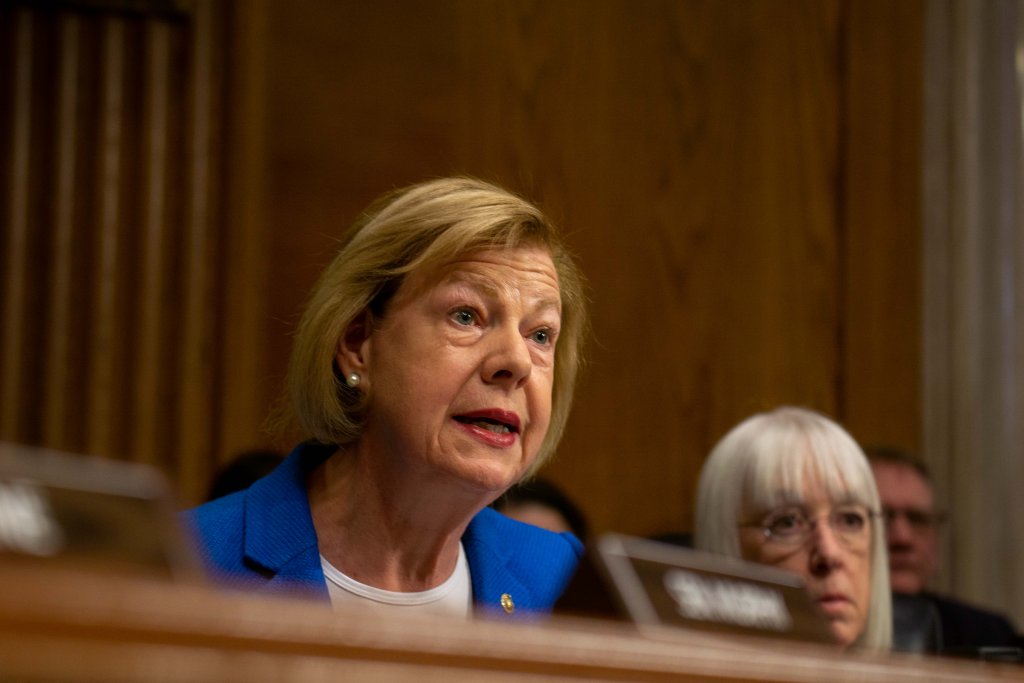 Sen. Tammy Baldwin (D-Wis.) asks how many studies Kennedy needs to see before deeming a medication safe. “With mifepristone, President Trump has not chosen a policy,” Kennedy says after several attempts to qualify the question. (Valerie Chu/MNS)
Sen. Tammy Baldwin (D-Wis.) asks how many studies Kennedy needs to see before deeming a medication safe. “With mifepristone, President Trump has not chosen a policy,” Kennedy says after several attempts to qualify the question. (Valerie Chu/MNS) Sen. Tim Kaine (D-Va.) questions Kennedy about a previous tweet about 9/11 and his past comments that people in power lie. (Valerie Chu/MNS)
Sen. Tim Kaine (D-Va.) questions Kennedy about a previous tweet about 9/11 and his past comments that people in power lie. (Valerie Chu/MNS) Sen. Chris Murphy (D-Conn.) questions one of Kennedy’s previous comments comparing pedophilia in the Catholic church to the administration of vaccines. “You’re not questioning science,” Murphy says. “You’ve made up your mind.” (Valerie Chu/MNS)
Sen. Chris Murphy (D-Conn.) questions one of Kennedy’s previous comments comparing pedophilia in the Catholic church to the administration of vaccines. “You’re not questioning science,” Murphy says. “You’ve made up your mind.” (Valerie Chu/MNS)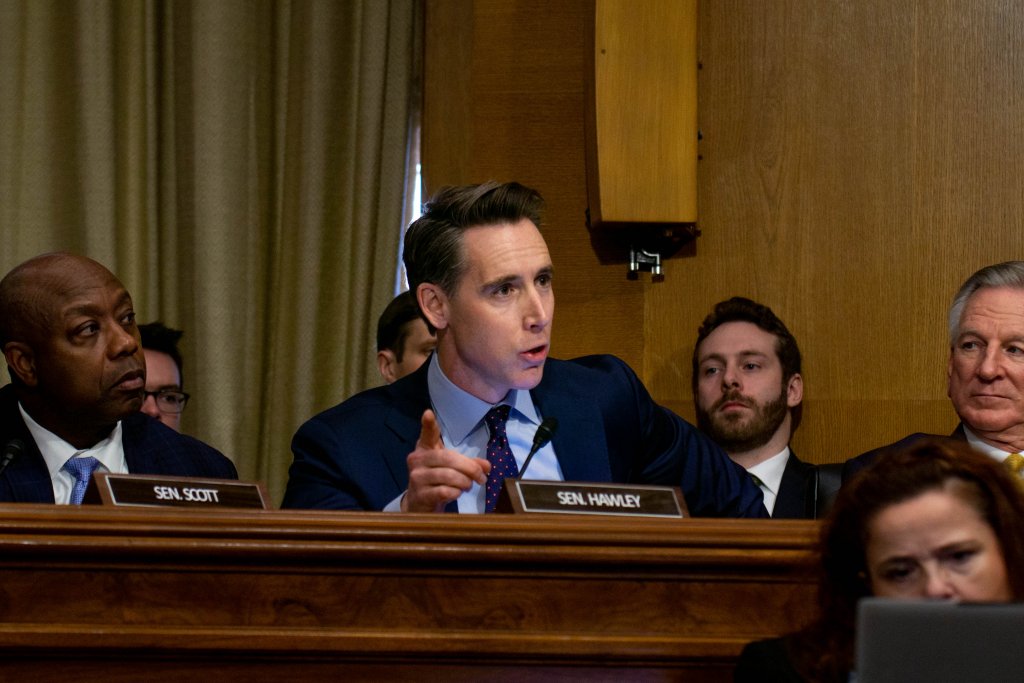 In response to questions from Sen. Josh Hawley (R-Mo.), Kennedy says that he would not support conducting federal research on fetal tissues from abortions and that he would not support gender affirming surgery for minors. “It’s unconscionable,” Kennedy says. (Valerie Chu/MNS)
In response to questions from Sen. Josh Hawley (R-Mo.), Kennedy says that he would not support conducting federal research on fetal tissues from abortions and that he would not support gender affirming surgery for minors. “It’s unconscionable,” Kennedy says. (Valerie Chu/MNS) Kennedy agrees with Sen. Jim Banks (R-Ind.) that “absolutely,” obesity is a public health and national security risk. Banks reassures Kennedy that he has his “full support.” (Valerie Chu/MNS)
Kennedy agrees with Sen. Jim Banks (R-Ind.) that “absolutely,” obesity is a public health and national security risk. Banks reassures Kennedy that he has his “full support.” (Valerie Chu/MNS)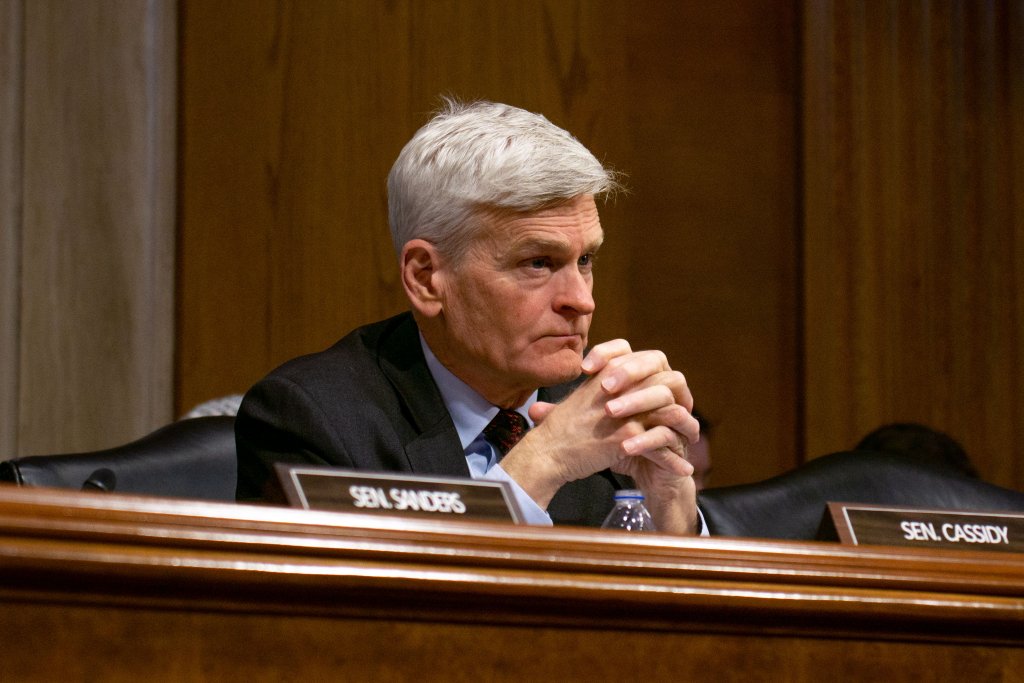 Sen. Bill Cassidy (R-La.) watches the hearing during a particularly intense moment, at times correcting statements Kennedy and other senators make on topics such as abortion. He is the chairman of the Senate Health, Education, Labor and Pensions Committee. (Valerie Chu/MNS)
Sen. Bill Cassidy (R-La.) watches the hearing during a particularly intense moment, at times correcting statements Kennedy and other senators make on topics such as abortion. He is the chairman of the Senate Health, Education, Labor and Pensions Committee. (Valerie Chu/MNS)One point of contention was what it takes for a drug to be considered safe, and whether Kennedy would retract his past comments casting doubt on the safety of certain vaccines and medications. Sen. Bill Cassidy (R-La.), Sen. Chris Murphy (D-Conn.), Sen. Angela Alsobrooks (D-Md.), Sen. Tammy Baldwin (D-Wis.) and several more senators all asked variations of that question — each focused on different topics.
“If we were to talk about peer-reviewed, replicable studies of a medication, would you say that you needed 10 trusted studies to get the same conclusion? Fifteen? Twenty trusted studies?” Baldwin asked. “What’s your number?”
Kennedy responded, “it completely depends on the kind of study you’re talking about.” Then, he added that on mifepristone, Trump has not chosen a policy, and he would implement that policy.
Many of Kennedy’s other statements were similar. He defended his previous statements, said he would evaluate the scientific evidence and stuck to that statement when senators cited specific scientific evidence.
Sen. Angela Alsobrooks (D-Md.) asked Kennedy to elaborate on a 2021 comment about how Black people should have different vaccine schedules than white people because their immune systems are “better than ours.”
At the hearing, Kennedy defended his earlier comments, saying that there was a series of studies which showed “differences in reactions to different products by different races.”
Alsobrooks shot back: “Your voice would be a voice that parents would listen to. That is so dangerous. I will be voting against your nomination because your views are dangerous to our state and to our country.” Several people in the hearing room began clapping.
Three hours later, Kennedy’s confirmation hearing ended.
“Thank you, Bobby!” several people shouted from the crowd as Kennedy shook hands with various senators before leaving the room. A group of people wearing lab coats in the back row watched silently.
Watch: Past comments on vaccines and abortion dominate RFK Jr. confirmation hearing
WASHINGTON – Robert F. Kennedy Jr., President Trump’s nominee for Secretary of Health and Human Services, appeared before the Senate Committee on Finance on Wednesday.
Kennedy’s previous comments on the efficacy of vaccines raised concern from Senate Democrats, and their questioning focused on this topic.
Watch the video report here:

